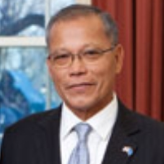Officials
Back to Officials


Offical

Name: Takesy, Asterio
Current Position: Previous Ambassador
Referring to President Obama’s birthplace of Hawai’i, the new ambassador from Micronesia recently greeted the President as a “fellow Pacific islander,” during a White House ceremony on January 18, 2012, welcoming new ambassadors to Washington, DC. Asterio Takesy is a senior Micronesian diplomat who has previously served as his country’s representative to the U.S. Formerly part of the Trust Territory of the Pacific Islands, established by the United Nations and administered by the U.S. beginning in 1947, Micronesia today depends on financial support from the U.S. pursuant to a Compact originally signed in 1986.
Takesy was born in Chuuk (formerly Truk) State, Micronesia, on May 25, 1944, just three months after the U.S. Navy destroyed a Japanese military base in Chuuk in Operation Hailstone, an important World War II naval battle. As a result of the Navy’s “island-hopping” strategy, however, the Japanese remained in control until the war’s end in August 1945. In 1963, Takesy graduated from Xavier High School, widely considered the country’s best high school and the alma mater of most of Micronesia’s senior leaders. From 1963 to 1970, Takesy attended the University of Guam and the University of New Mexico, where he studied Marine Biology, Political Science and Public Administration.
Takesy began his career as an administrative assistant in the Chuuk District Education Department, followed by stints in the Trust Territory of the Pacific Islands Headquarters Information Office on Saipan, Northern Mariana Islands, and service as chief clerk in the former Congress of the Micronesian House of Representatives. In 1975 he served as assistant secretary for the Micronesia Constitutional Convention, which led ultimately to Micronesia’s independence in 1979. In the meantime, Takesy was executive director of the Commission on Future Political Association with the U.S.
From 1979 to 1982, Takesy served as the Representative of Micronesia to the U.S, in effect becoming Micronesia’s first ambassador to the U.S., although that term was not officially used. Addressing Americans in a 1980 interview with The Washington Post, Takesy explained that “Our constitution is very much like yours...except that more rights are specified in our Bill of Rights.” That same year he argued at the United Nations that Micronesia was not yet ready to accept the independence that the United States wanted to grant in 1981 because more than thirty years of U.S. rule had turned his country into a welfare state without providing an infrastructure for a viable national economy. He noted, '”I am the only one in my area who still knows how to navigate an oceangoing canoe from island to island.”
Returning home in 1982, he served as Deputy Secretary of Foreign Affairs until 1989, when he became Acting Secretary until 1991. Responding in 1985 to the introduction of investment from Japan, he said, “The Japanese went about it the right way. They asked us what we need, what we want. The Americans are always telling us what to do. They say, ‘This is what your problem is, and here's how you must solve it.’”
Takesy also found time to represent the Western Namonwitto and Hall Islands of Chuuk State at the Second Micronesia Constitutional Convention in 1990.
From 1991 to 1995, Takesy served as Micronesia’s Secretary of Resources and Development, and then as Secretary for Foreign Affairs from 1995 to 1997. He left that job to work as executive director for the Joint Committee on Compact Economic Negotiations from 1997 to 2000.
In January 2003, Takesy left Micronesia to become the executive director of the South Pacific Regional Environmental Program (SPREP) in Apia, Samoa, where he served two three-year terms and returned to Micronesia in January 2009. SPREP, a regional organization established by the governments of the Pacific region to look after its environment, has been particularly vocal in advocating measures to curb global warming, which is a threat to many low-lying Pacific islands. Shortly after his return to Micronesia, he rejoined government service as a Senior Advisor on the Five-year Compact Review.
Takesy has served on the Boards of several organizations, including the Micronesian Telecommunications Corporation, the Micronesian Maritime Authority (now the National Oceanic Resource Management Authority) and the National Fisheries Corporation. Takesy is married to Justina Yangilmau of Palau. They have three daughters and four grandchildren.
Environment: Future Leaders Spearhead Change, The Need to Work with Communities (by Asterio Takesy, Islands Business)
Takesy Full of Optimism for the Future (by Asterio Takesy)
- Latest News
- D.C. Public Schools will Teach all Second-Graders to Ride a Bike
- New Rule in Germany Limits Sales of Sex-Themed E-Books to 10pm to 6am
- What Happened to the 6-Year-Old Tibetan Boy the Chinese Government Kidnapped 20 Years Ago?
- U.S. Ambassador to Turkey Photoshops his Hair Color to Mock Turkish Mayor
- Mystery Artist Calls Attention to Unfixed Potholes by Drawing Penises around Them



